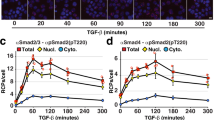Abstract
β-catenin (CTNNB1) is a dual-function cell–cell adhesion/transcriptional co-activator protein and an essential transducer of canonical Wnt signals. Although a number of established techniques and reagents are available to quantify the nuclear signaling activity of β-catenin (e.g., TCF-dependent reporter assays, nuclear accumulation of β-catenin, and generation of N-terminally hypophosphorylated β-catenin), there are cell-type and context-dependent limitations of these methods. Since the posttranscriptional stabilization of β-catenin outside of the cadherin complex appears universally required for β-catenin signaling, the following method allows for simple assessment of the cadherin-free fraction of β-catenin in cells, using a GST-tagged form of ICAT (Inhibitor of β-Catenin and Tcf) as an affinity matrix. This method is more sensitive and quantitative than immunofluorescence and may be useful in studies that implicate TCF-independent signaling events.
Access this chapter
Tax calculation will be finalised at checkout
Purchases are for personal use only
Similar content being viewed by others
References
Goentoro L, Kirschner MW (2009) Evidence that fold-change, and not absolute level, of beta-catenin dictates Wnt signaling. Mol Cell 36:872–884
Cox RT, Kirkpatrick C, Peifer M (1996) Armadillo is required for adherens junction assembly, cell polarity, and morphogenesis during Drosophila embryogenesis. J Cell Biol 134:133–148
Cox RT, Pai LM, Kirkpatrick C, Stein J, Peifer M (1999) Roles of the C terminus of Armadillo in Wingless signaling in Drosophila. Genetics 153:319–332
Song LN, Herrell R, Byers S, Shah S, Wilson EM, Gelmann EP (2003) Beta-catenin binds to the activation function 2 region of the androgen receptor and modulates the effects of the N-terminal domain and TIF2 on ligand-dependent transcription. Mol Cell Biol 23:1674–1687
Truica CI, Byers S, Gelmann EP (2000) Beta-catenin affects androgen receptor transcriptional activity and ligand specificity. Cancer Res 60(17):4709–4713
Essers MA, de Vries-Smits LM, Barker N, Polderman PE, Burgering BM, Korswagen HC (2005) Functional interaction between beta-catenin and FOXO in oxidative stress signaling. Science 308:1181–1184
Hoogeboom D, Essers MA, Polderman PE, Voets E, Smits LM, Burgering BM (2008) Interaction of FOXO with beta-catenin inhibits beta-catenin/T cell factor activity. J Biol Chem 283:9224–9230
Staal FJ, Noort Mv M, Strous GJ, Clevers HC (2002) Wnt signals are transmitted through N-terminally dephosphorylated beta-catenin. EMBO Rep 3:63–68
van Noort M, Meeldijk J, van der Zee R, Destree O, Clevers H (2002) Wnt signaling controls the phosphorylation status of beta-catenin. J Biol Chem 277:17901–17905
Maher MT, Flozak AS, Stocker A, Chenn A, Gottardi CJ (2009) Activity of the β-catenin phospho-destruction at cell-cell contacts is enhanced by cadherin-based adhesion. J Cell Biol 186:219–228
Maher MT, Mo R, Flozak AS, Peled ON, Gottardi CJ (2010) Beta-catenin phosphorylated at serine 45 is spatially uncoupled from beta-catenin phosphorylated in the GSK3 domain: implications for signaling. PLoS One 5:e10184
Zhang F, Phiel CJ, Spece L, Gurvich N, Klein PS (2003) Inhibitory phosphorylation of glycogen synthase kinase-3 (GSK-3) in response to lithium. Evidence for autoregulation of GSK-3. J Biol Chem 278(35):33067–33077
Tago K, Nakamura T, Nishita M, Hyodo J, Nagai S, Murata Y, Adachi S, Ohwada S, Morishita Y, Shibuya H, Akiyama T (2000) Inhibition of Wnt signaling by ICAT, a novel beta-catenin-interacting protein. Genes Dev 14:1741–1749
Tutter AV, Fryer CJ, Jones KA (2001) Chromatin-specific regulation of LEF-1-beta-catenin transcription activation and inhibition in vitro. Genes Dev 15:3342–3354
Graham TA, Clements WK, Kimelman D, Xu W (2002) The crystal structure of the beta-catenin/ICAT complex reveals the inhibitory mechanism of ICAT. Mol Cell 10:563–571
Daniels DL, Weis WI (2002) ICAT inhibits beta-catenin binding to Tcf/Lef-family transcription factors and the general coactivator p300 using independent structural modules. Mol Cell 10:573–584
Gottardi CJ, Gumbiner BM (2004) Distinct molecular forms of beta-catenin are targeted to adhesive or transcriptional complexes. J Cell Biol 167:339–349
Choi HJ, Huber AH, Weis WI (2006) Thermodynamics of beta-catenin-ligand interactions: the roles of the N- and C-terminal tails in modulating binding affinity. J Biol Chem 281:1027–1038
McCrea PD, Gumbiner BM (1991) Purification of a 92-kDa cytoplasmic protein tightly associated with the cell-cell adhesion molecule E-cadherin (uvomorulin). Characterization and extractability of the protein complex from the cell cytostructure. J Biol Chem 266:4514–4520
Pronobis MI, Rusan NM, Peifer M (2015) A novel GSK3-regulated APC:Axin interaction regulates Wnt signaling by driving a catalytic cycle of efficient betacatenin destruction. Elife 4:e08022
Author information
Authors and Affiliations
Corresponding authors
Editor information
Editors and Affiliations
Rights and permissions
Copyright information
© 2016 Springer Science+Business Media New York
About this protocol
Cite this protocol
Flozak, A.S., Lam, A.P., Gottardi, C.J. (2016). A Simple Method to Assess Abundance of the β-Catenin Signaling Pool in Cells. In: Barrett, Q., Lum, L. (eds) Wnt Signaling. Methods in Molecular Biology, vol 1481. Humana Press, New York, NY. https://doi.org/10.1007/978-1-4939-6393-5_6
Download citation
DOI: https://doi.org/10.1007/978-1-4939-6393-5_6
Published:
Publisher Name: Humana Press, New York, NY
Print ISBN: 978-1-4939-6391-1
Online ISBN: 978-1-4939-6393-5
eBook Packages: Springer Protocols




